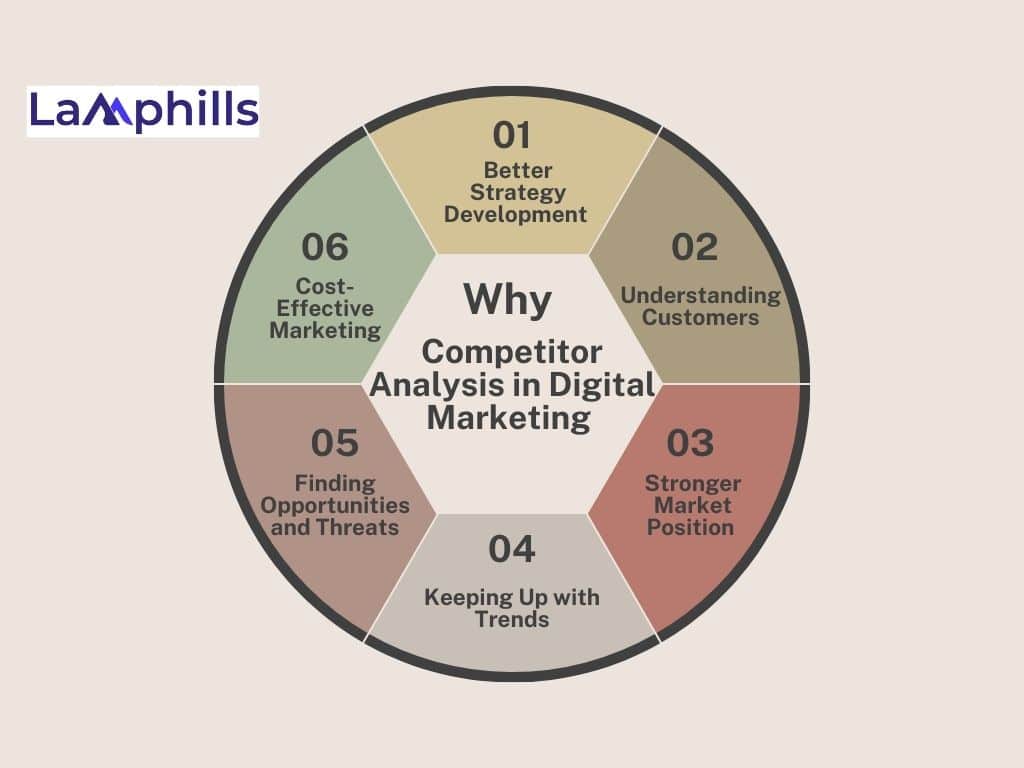As a digital marketer, knowing how to do competitor analysis in digital marketing is a key advantage. The online business world is very challenging, so knowing what your competitors are good at and where they could be stronger is important. This knowledge helps you stay adaptable and competitive.
This means finding out what their competitors are doing to improve and connect better with their customers. A big part of this is doing a digital competitive analysis. This gives you a look at how your competitors use online strategies, helping you to focus on your strengths and improve your weak points.
Whether you work with a big brand, a start-up, or a small business, competitive analysis in digital marketing is a must-have tool. We’ve put together every process and tool for a complete digital marketing competitor analysis in 7 easy steps. But first:
Key Points
- Check out your competitors’ websites and social media profiles. See what kind of content they post, how often they post, and how much people interact with their posts.
- Competitor analysis is an ongoing process, not just a one-time task. By regularly checking what your competitors are doing and adjusting your strategies based on what you find, you can stay ahead in digital marketing
- Identifying your competitors can save you time, money, and effort. Plus, you can use your competition as a source of new ideas
- Analyze the social media platforms your competitors use, the content they post, their engagement levels, and their overall strategy. This helps in identifying effective social media tactics
- Analyzing competitors wouldn’t be complete without looking at their advertising efforts. Check if your competitors are running online ads on Google, Facebook, or Instagram
What Is Competitor Analysis?
Competitor analysis is when you look at what other businesses like yours are doing. You find out what they are doing well and what they are not doing well. This helps you understand how you can improve your own business.
For example, if you own a coffee shop, you would look at other coffee shops nearby. You might check their menu, prices, customer reviews, and their social media pages. If you see that they have a popular drink that you don’t offer, you might add something similar to your menu. Or if customers are complaining about their slow service, you can focus on making sure your service is fast to attract those customers.
In competitor analysis, you research and study the marketing strategies of other companies in your market. With this research, you’re able to understand what other brands in your niche are doing to attract and keep customers. The analysis looks at many factors to find out what drives traffic to your competitors’ websites and makes their ads successful. It shows where your competitors are strong and where they have weaknesses, helping you see where you can improve and find new opportunities.
Read Also: How to Monitor Competitors in 10 Effective Steps
But, do you know who your main competitors are?
Who Are Your Competitors?
While you can succeed without paying attention to your competition, it’s a risky path. Your competitors are on the same journey to succeed in business. They are likely doing some things right and some things wrong. By studying them, you can learn valuable lessons on what to do and what to avoid in your business.
Also, knowing your competitors helps you identify where you can stand out. Highlighting your unique strengths gives your audience a clear choice between you and your competitors.
In short, identifying your competitors can save you time, money, and effort. Plus, you can use your competition as a source of new ideas. But maybe you think your business is so unique that you have no competition. While that’s impossible, you likely have more competitors than you realize.
Types of Competitors

Before we go on, let’s look at the different types of competition you may face. There are five types of competitors: direct, potential, indirect, future, and replacement competitors.
#1. Direct Competitors
These are businesses directly competing for your customers. For example, If you run an online store selling handmade jewelry, your direct competitors are other online stores selling handmade jewelry, like Etsy shops.
#2. Potential Competitors
These businesses do the same thing as you and target similar customers but aren’t currently in your market area. They could become competitors if they decide to enter your market. For instance, if you offer digital marketing services in your town, a potential competitor could be a digital marketing agency based in a nearby city that hasn’t yet expanded to your market.
#3. Indirect Competitors
These businesses are in the same category but sell different products or services. For instance, If you sell smartphones, an indirect competitor might be a company that sells tablets. They don’t sell smartphones but attract customers interested in mobile technology.
#4. Future Competitors
These are like potential competitors but are more likely to enter your market soon. They might be larger national companies that haven’t entered your local market yet. Think of them as a step between potential and direct competitors. For example, if you own a local bookstore, a future competitor might be a large national bookstore chain planning to open a branch in your area.
#5. Replacement Competitors
These provide alternatives to your services that solve the same problems. For instance, if you own a residential cleaning service, a replacement competitor could be a company selling high-quality home cleaning equipment, encouraging people to clean their own homes. Or, if you run a taxi service, a replacement competitor might be a ride-sharing app like Uber or Lyft, offering a different way to solve the same transportation problem.
All these types of competitors can take away market share from your business now or in the future. So, how do you identify your competitors? Start by using a search engine to see which businesses are out there.
Now that we’ve understood the basics, let’s see why a competitor analysis is necessary in digital marketing.
Why Do You Need to Conduct a Competitor Analysis in Digital Marketing?

One time, I was paired with Joel, a digital marketing pro in our firm, on a project. It was a digital marketing campaign for a small business, a local cafe struggling to get new customers. We worked hard on social media posts, set up ads, and optimized the website for search engines. But the results were disappointing.
We were both confused until Joel found the Facebook page of a nearby competitor. Their posts were lively, their ads were engaging, and their website was smooth. That was my “aha” moment, the key to successful digital marketing wasn’t just about what we did, but also about understanding what our competitors were doing.
This experience taught me the valuable lesson of competitor analysis in digital marketing. Let me share some importance of competitor analysis, especially based on my experience
#1. Better Strategy Development
By looking at competitors, you can see what works and what doesn’t. For example, when Joel and I found the engaging content of a nearby café, we changed our strategy to better connect with our audience.
#2. Understanding Customers
Competitor analysis shows what customers like and how they behave. Seeing how the competitor’s lively posts worked helped us understand what our target customers wanted.
#3. Stronger Market Position
Knowing where you stand compared to competitors helps you find your unique strengths. Our look at the competitor’s smooth website and engaging ads showed us where we could improve, helping us position the café better.
#4. Keeping Up with Trends
Watching competitors helps you stay up-to-date with market trends. The competitor’s good use of social media and ads showed us the latest practices we needed to follow.
#5. Finding Opportunities and Threats
Competitor analysis can reveal new chances and possible dangers. By understanding the competitor’s strengths, we saw areas where the café could get better and potential risks from their success.
#6. Cost-Effective Marketing
Learning from competitors can help you avoid costly mistakes. Our early efforts weren’t working until we analyzed the competitor’s strategies, saving us from wasting more resources.
#7. Boosting Innovation
Analyzing competitors can give you new ideas. The creative and engaging content from the competitor inspired us to come up with fresh, appealing content for the café.
#8. Better Decision Making
With a clear picture of the competitive landscape, you can make smarter choices. The insights we gained from the competitor’s successful tactics helped us make better decisions for our marketing efforts, leading to more effective campaigns.
From my experience with the café project, I’ve seen how competitor analysis can greatly improve a digital marketing strategy, leading to better results and a stronger market presence.
How to Do Competitor Analysis in Digital Marketing
Competitor analysis in digital marketing means studying what your competitors are doing online to learn from them and improve your strategies. Here’s a comprehensive guide to doing it, illustrated with my own experience.
Here’s a checklist on Competitor Analysis.
#1. Identify Your Competitors
The first step in a competitor analysis is to find out who your competitors are. Start by defining your market and understanding who offers similar products or services. For the café, I looked at other local coffee shops and even larger chains in our area. I used tools like Google Search, Yelp, and social media platforms to find businesses that our target audience might consider as alternatives.
Identifying competitors can be done through online searches, social media, and industry reports.
#2. Analyze Their Online Presence

Once you have a list of competitors, it’s time to look at their online presence. This means checking out their website, and content strategy, and checking their social media profiles. Take note of the type of content they post, the frequency of their posts, and how they interact with their audience. For instance, our competitor posted daily on Instagram, engaging with customers through comments and direct messages. They shared high-quality photos of their menu items, promotions, and events, which kept their audience interested and engaged.
Joel and I spent hours on competitor websites, noting their design, user experience, and the kind of content they posted. Tools like SimilarWeb and Ahrefs helped us find out where their traffic came from and which pages were popular.
For social media, I followed their profiles and analyzed their posts’ engagement levels, frequency, and content types. It was interesting to see how different businesses interacted with their audience and the tactics they used to drive engagement.
#3. Examine Their Website and Content Marketing
Content is key in digital marketing. Knowing what works for your competitors’ audience is important. Look at their design, user experience, and content type. See how easy it is to navigate their site, the quality of their visuals, and the information they provide.
Check if they have a blog, what topics they cover, and how often they update it. For us, we found that our competitor’s website was attractive, easy to navigate, and regularly updated with blog posts about coffee trends, recipes, and events. This kept their audience informed and engaged.
We looked at their blogs, videos, infographics, and other content to see what topics they covered, how often they posted, and the engagement they got. We noticed that competitors were posting behind-the-scenes videos, customer testimonials, and user-generated content. By using similar content, we improved our engagement and built a stronger connection with our audience.
#4. Check Their SEO

Search engine optimization (SEO) is an important part of digital marketing. By studying your competitors’ SEO strategies, you can learn a lot about their marketing efforts. Use tools like Google’s Keyword Planner, Ahrefs, or SEMrush to find out which keywords your competitors are using.
Look at their meta descriptions, title tags, and other SEO elements. Check their backlinks to see which sites are linking to them. We learned that local SEO is crucial. Our competitors used local keywords, Google My Business listings, and online reviews to attract nearby customers. Using these strategies helped us improve our local search rankings.
By understanding their SEO strategy, we could find areas where we could improve our own SEO efforts.
#5. Review Their Social Media Strategy
Social media is great for connecting with people. Check out the platforms your competitors use, the kind of content they post (like photos, videos, or stories), and how they interact with their followers. Pay attention to how often they post, the style of their messages, and how much they engage with their audience. Our competitor was very active on Facebook and Instagram, sharing different types of posts, stories, and live videos. They used Instagram stories well to show daily specials and behind-the-scenes content, which helped them connect personally with their audience.
#6. Evaluate Their Advertising
Analyzing competitors wouldn’t be complete without looking at their advertising efforts. Check if your competitors are running online ads on Google, Facebook, or Instagram. Look at the types of ads they use, the messages they send, and the calls to action they include. Examine their ad copy, visuals, and targeting strategies. For instance, our competitor often ran Instagram ads promoting special offers and new menu items. These ads were visually appealing and aimed at local coffee lovers, helping them attract more customers.
Using tools like Facebook Ad Library and Google’s Ad Preview Tool, we could see the types of ads our competitors were running, their ad copy, and their targeting strategies.
This analysis helped us create more effective ad campaigns. For example, we saw a competitor running a successful promotion for a new drink. We adopted a similar promotion but added our unique twist, leading to a significant increase in our ad engagement and sales.
#7. Learn from Their Successes and Mistakes
While it’s important to follow your competitors’ successful strategies, it’s equally important to learn from their mistakes. Identify what your competitors are doing well and think about how you can incorporate similar strategies. Also, take note of any mistakes or negative feedback they receive and avoid making the same errors.
For example, we saw that our competitor’s Instagram stories were very engaging, so we started using a similar approach for our café. But we also saw that they got complaints about slow service, so we made sure to fix that issue quickly in our own operations.
By following these steps, you can learn a lot from your competitors and improve your digital marketing. Competitor analysis helps you understand the market, find new opportunities, and create better strategies to reach your target audience.
Wrap Up
Competitor analysis is an ongoing process, not just a one-time task. By regularly checking what your competitors are doing and adjusting your strategies based on what you find, you can stay ahead in digital marketing. My initial mistake taught me how important competitor analysis is. Now, every campaign I work on begins with a thorough competitor analysis, ensuring we’re not just keeping up but leading.
By following these steps, you can discover what your competitors are doing and use that knowledge to boost your digital marketing success. Remember, the key is not just to see what your competitors are doing, but to learn from their successes and mistakes to keep improving your strategies.
Frequently Asked Questions
What are the 5 steps to Analyse your competitor?
- Identify Your Competitors: Find out who your main competitors are.
- Study Their Social Media Ads: Look at the ads they are running on social media.
- Analyze Their Google Ads: Check out their Google ad campaigns.
- Use SEO Tools: Use tools to track how well they are doing in organic search results.
- Evaluate Their Content Marketing: Assess the content they produce, like blogs and videos.
How do you draw a competitor analysis?
Competitor analysis means studying your competitors to understand their products, sales, and marketing. Your business is more likely to succeed if you know a lot about your direct competitors. By doing competitor analysis, you can see where the market is heading and stay ahead.
What are the 5 Cs of competitors?
The 5Cs are:
1. Company: Your own business.
2. Collaborators: Your partners and allies.
3. Customers: The people who buy your products or services.
4. Competitors: Other businesses that sell similar products or services.
5. Context: The environment in which your business operates.
What are the 5 types of competitors in marketing?
There are five types of competitors:
1. Direct Competitors: Businesses that offer the same products or services as you.
2. Potential Competitors: Businesses that could become your competitors in the future.
3. Indirect Competitors: Businesses that offer different products or services that can still meet the same customer needs.
4. Future Competitors: Businesses that might enter your market and compete with you later.
5. Replacement Competitors: Alternatives that customers might use instead of your product or service.
Similar Articles
How to Monitor Competitors in 10 Effective Steps
WHAT IS MEDIA ANALYSIS: Definitions, Techniques, and Personal Insights
Understanding Your Customers: Advanced Techniques in Audience Analysis






